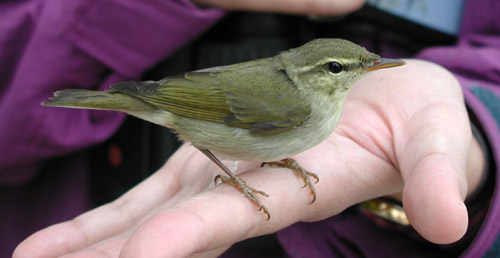English Name : Arctic Warbler
Scientific Name : Phylloscopus borealis
Page 2
Since the shape of the superciliums, I guess that the following birds may not be ssp. xanthodryas, breeded in Honshu.
| 11. 25th Sep. 2004 Hegura-jima, Wajima-shi, Ishikawa Pref. This bird, at first, was identified as Willow Warbler P. trochilus in the field. Maybe this mis-identification was caused by having no wingbar and graysh upperparts. The habitat was pine wood, that Willow Warbler is not usually favorite. On this island, the Willow Warblers is usually seen in forest edge or grassland. |
|
| 12. 25th Sep. 2004 Hegura-jima, Wajima-shi, Ishikawa Pref. The same bird as on picture No.11. The face impression was seen as Arctic Warbler as me. Thus 'jizz' is needed the obeserver's experence. |
|
| 13. 25th Sep. 2004 Hegura-jima, Wajima-shi, Ishikawa Pref. The same bird as on picture No.11 and 12. Note the left side of the face. This bird has atypical supercilium, that extend to front well and curve downword near the nostril. |
|
| 14. 25th Sep. 2004 Hegura-jima, Wajima-shi, Ishikawa Pref. The same bird as on pictures No.11 to 13. Several Arctic Warblers occured nearby this birds. The longer supercilium (to the front), less greenish, grayer upperparts and no wing-bar are seen to be so different with the other Arctic Warblers. These character might cause mis-identification. |
|
| 15. 25th Sep. 2004 Hegura-jima, Wajima-shi, Ishikawa Pref. The same picture as No. 15. The grater coverts are very worn and the wing-bar is very indistinctive. The mantle's color is graysh and less green. Therefore, this bird is considered as an adult. |
|
| 16. 25th Sep. 2004 Hegura-jima, Wajima-shi, Ishikawa Pref. another bird taken on the same date with the pictures No.11-15. The wing-bars are distinctive. This bird is considered as a 1st winter. |
|
 |
17. 20th Oct. 2002. Awa-shima, Iwafune-gun, Niigata Pref. Photo by Ken-ichiro Takada This bird has grayish crown and mantle. The grater coverts wing-bar is very indistinctive. The median coverts wing-bar is not seen. The eyestripe behind the eye is thinner than normal birds. But Ken-ichiro Takada suggest that it has possible silghtly cold iris coloration. Therefore, it could be possibly first winter. |